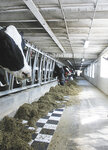WAUSAU, Wis. – The Ninnemann family of Wausau wanted to continue dairying on their Marathon County farm; but they knew in order to do so, they would have to make some changes.
Ninnemann Enterprises is a fifth-generation family dairy farm operated by brothers Herb and Fred Ninnemann, along with Fred’s three sons, Aaron, Adam and Alex. They recently retrofitted their 115-cow tiestall barn into a 125-cow freestall barn equipped with two Lely A5 robotic milking systems.
The Ninnemanns shared their retrofitted barn during an open house Sept. 8.
“My dad and my uncle are getting older, and we needed to reduce the amount of physical labor they were putting in,” Aaron said. “My brothers didn’t want to milk cows for the rest of their lives, and I work full-time off the farm too.”
Automation has intrigued the Ninnemanns for a few years, but they said investing in a new facility to make that transition was not possible for their family farm.
“I called up Seehafer and asked them if they had ever successfully put robots into a tiestall barn,” Aaron said. “I was surprised to learn they had, and he gave me some places to go tour. Adam and I went to one, and we were sold. We knew how we were going to move the farm forward as a dairy.”
Retrofitting their existing facility made financial sense for the Ninnemanns.
“We had a nice barn that was in good, solid shape,” Adam said. “We have a stationary mixer upstairs in the barn. Our manure lagoon was connected to the barn and in excellent condition. Retrofitting allowed us to work with what we had rather than take on the debt that would come with a new building.”
An addition to the tiestall barn was made to house the robots and add extra stalls.
In order to complete the renovation, the Ninnemanns sold their herd of cows in May 2021, keeping only a handful of dry cows. The family spent the next three months working on turning their tiestall barn into a freestall barn.
Aug. 22, 2021, marked the startup of the new system for the Ninnemanns. The brothers agreed the transition went well.
“The first week the hours were long, but it wasn’t really hard,” Adam said. “The cows adjusted and settled in pretty well, all things considered.”
To restock their herd, the Ninnemanns purchased 75 cows from one herd to add to their own dry cows that were calving back in. Once those initial cows became accustomed to the routine of robotic milking, they filled out the remainder of the herd with cows purchased at livestock sales.
The cows exit the robots through a foot bath, which Aaron said runs each day from morning until the afternoon.
“We might run it too much, but we have also seen zero foot issues,” Aaron said. “The cows are now only trimmed after dry off. Running the foot bath has just become part of the routine.”
Cows are fed a total mixed ration three times daily using carts. Along with the milking robots, the Ninnemanns also purchased an automatic feed pusher.
“We run the Juno every hour on the hour,” Aaron said. “It’s maybe a little more often than it needs to be, but we found it was complicated keeping track of where it was in its schedule and knowing when we could go through with the carts to put out more feed.”
To convert the stalls in the tiestall barn, they installed flexible stall dividers and placed mats in each of the stalls.
“We really liked the flexibility of the dividers but also how sturdy they are,” Adam said. “The cows really aren’t able to get themselves caught under the stalls, and they seem very comfortable laying in them.”
Stalls are bedded by hand daily. The Ninnemanns bed with a paper byproduct. That byproduct is then mixed with lime to make a bedding that the Ninnemanns have been happy with thus far.
“We weren’t interested in the wear and tear on the equipment that comes with sand, and we have an earthen lagoon,” Aaron said. “This is heavy enough it stays up in the stalls, there isn’t a lot of dust, and it absorbs really well.”
Because of the single-row setup, an alley scraper was installed that runs continuously to keep the freestall walkway clean.
“Taking care of the herd is easily a one-person job even with feeding and bedding by hand,” Adam said. “Everything just works out very efficiently.”
Despite the jobs that require manual labor, Aaron said they could not be happier with their choice to install the robotic milking system.
“You learn so much about the cows from the robots,” he said. “The data is astounding, and I really enjoy looking at and analyzing it.”
Fetch cows have not presented much of an issue for the Ninnemanns. When cows that are late in their lactation start stretching out their robot visits, the Ninnemanns let them go as long as 14 to 16 hours before seeking those cows out.
Considering the added technology has allowed his family’s dairy farm to continue, Adam said others should consider changing the way they farm as well.
“If someone is thinking about robots, I would encourage them to just pull the trigger and do it,” Adam said. “We have no regrets looking back. It really changes your life in the best possible way.”



Comments
No comments on this item Please log in to comment by clicking here